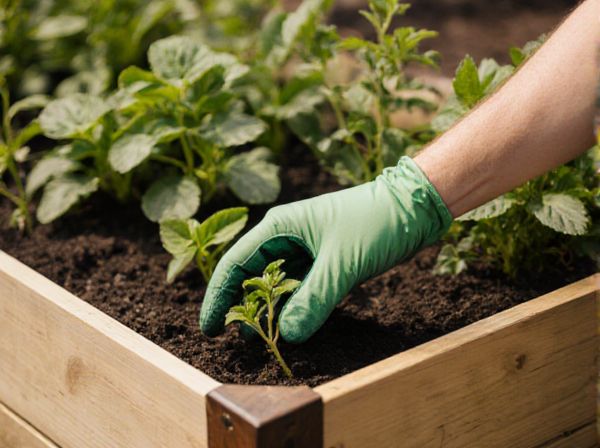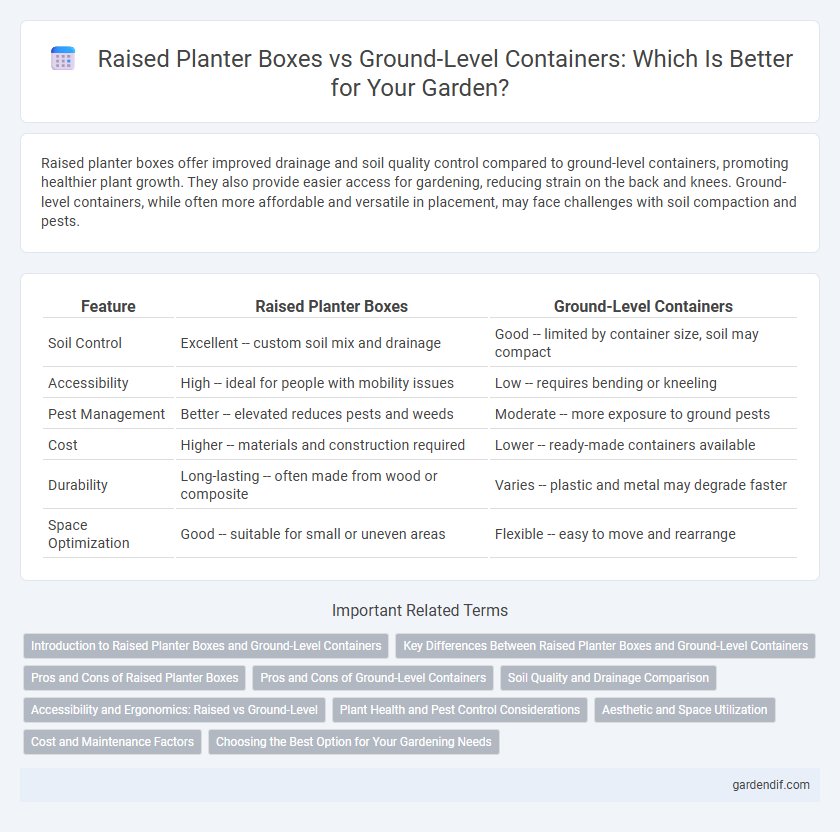
Raised planter boxes vs ground-level containers Illustration
Raised planter boxes offer improved drainage and soil quality control compared to ground-level containers, promoting healthier plant growth. They also provide easier access for gardening, reducing strain on the back and knees. Ground-level containers, while often more affordable and versatile in placement, may face challenges with soil compaction and pests.
Table of Comparison
| Feature | Raised Planter Boxes | Ground-Level Containers |
|---|---|---|
| Soil Control | Excellent -- custom soil mix and drainage | Good -- limited by container size, soil may compact |
| Accessibility | High -- ideal for people with mobility issues | Low -- requires bending or kneeling |
| Pest Management | Better -- elevated reduces pests and weeds | Moderate -- more exposure to ground pests |
| Cost | Higher -- materials and construction required | Lower -- ready-made containers available |
| Durability | Long-lasting -- often made from wood or composite | Varies -- plastic and metal may degrade faster |
| Space Optimization | Good -- suitable for small or uneven areas | Flexible -- easy to move and rearrange |
Introduction to Raised Planter Boxes and Ground-Level Containers
Raised planter boxes offer enhanced drainage and soil control, making them ideal for growing a variety of plants in limited spaces. Ground-level containers provide flexibility and ease in arranging plants directly on the soil surface, often suitable for larger or deeper-rooted species. Both options optimize gardening efficiency by addressing specific plant needs and site conditions.
Key Differences Between Raised Planter Boxes and Ground-Level Containers
Raised planter boxes offer superior drainage and soil control compared to ground-level containers, reducing the risk of waterlogging and root rot. They provide easier access for planting and maintenance, minimizing the need for bending or kneeling. Ground-level containers typically retain more moisture and can limit root growth due to soil compaction and lower aeration.
Pros and Cons of Raised Planter Boxes
Raised planter boxes offer improved soil drainage and reduce soil compaction, promoting healthier root growth compared to ground-level containers. They provide better pest control and easier access for gardening, minimizing back strain during planting and maintenance. However, raised boxes can require more frequent watering and higher initial costs due to construction materials and setup.
Pros and Cons of Ground-Level Containers
Ground-level containers offer improved root growth due to unrestricted soil volume and natural temperature regulation, enhancing plant health and yield. They are generally less expensive and easier to set up compared to raised planter boxes but can be more susceptible to soil-borne pests and poor drainage. Maintenance challenges include potential soil compaction and limited control over soil quality, which may affect long-term plant productivity.
Soil Quality and Drainage Comparison
Raised planter boxes offer superior soil quality and drainage compared to ground-level containers, as they allow for better soil aeration and prevent waterlogging with enhanced drainage systems. These boxes enable gardeners to control soil composition more precisely, reducing compaction and promoting healthier root growth. Ground-level containers often suffer from poor drainage and soil compaction, limiting nutrient availability and increasing the risk of root rot.
Accessibility and Ergonomics: Raised vs Ground-Level
Raised planter boxes offer superior accessibility by reducing the need for bending or kneeling, making them ideal for individuals with mobility issues or back problems. Ground-level containers, while more traditional, often require more physical effort to tend due to their low height, which can lead to discomfort during prolonged gardening. Ergonomically, raised boxes promote better posture and ease of maintenance, enhancing the overall gardening experience.
Plant Health and Pest Control Considerations
Raised planter boxes improve plant health by providing better soil drainage and root aeration compared to ground-level containers, reducing the risk of root rot and fungal diseases. Elevated positions in raised boxes also help deter common garden pests such as slugs and snails, which are less likely to access plants above ground. Soil temperature in raised planters tends to be warmer, promoting faster growth and reducing stress-related vulnerabilities to pests and pathogens.
Aesthetic and Space Utilization
Raised planter boxes offer enhanced aesthetic appeal with defined edges and structured organization, creating a visually pleasing garden layout. They maximize space utilization by elevating plants, allowing better access to soil and reducing ground-level clutter, ideal for small or urban gardens. Ground-level containers provide flexibility and portability but may lack the cohesive design and efficient space management of raised planter boxes.
Cost and Maintenance Factors
Raised planter boxes typically incur higher initial costs due to materials like treated wood or composite, but they offer superior drainage and soil control, reducing long-term maintenance expenses. Ground-level containers are generally more affordable upfront with basic plastic or fabric options, yet they may demand more frequent soil replacement and pest management. Considering ongoing maintenance, raised boxes often save time and resources by minimizing weeding and improving plant health, which can offset their higher setup investment.
Choosing the Best Option for Your Gardening Needs
Raised planter boxes offer superior soil drainage and temperature control, making them ideal for gardeners seeking optimal root health and extended growing seasons. Ground-level containers provide greater flexibility in placement and can accommodate larger plants, perfect for small spaces or urban gardening. Evaluating your garden's sunlight exposure, space constraints, and plant types will help determine which container style best suits your horticultural goals.
Raised planter boxes vs ground-level containers Infographic

 gardendif.com
gardendif.com